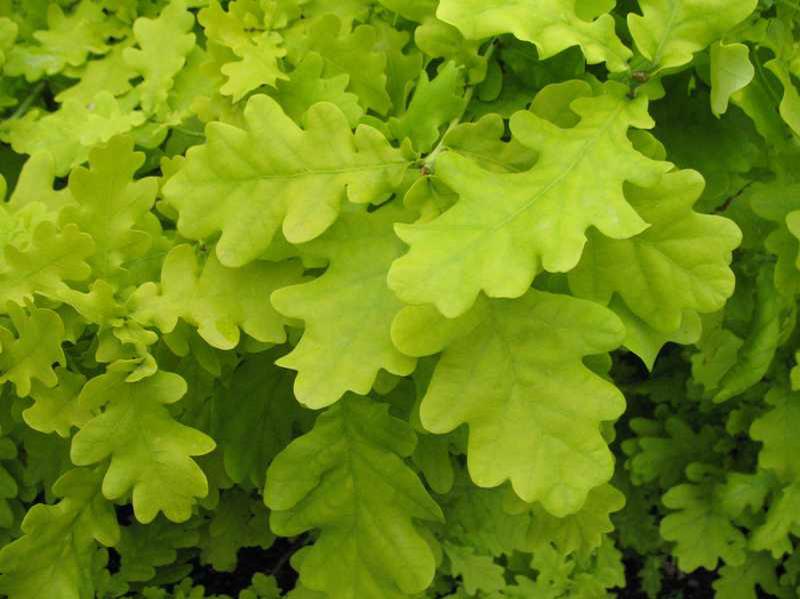English Oak (Quercus Robur ‘Concordia’)
English Oak
Quercus robur, commonly called English oak, is native to mixed woodland areas from the British Isles to the Caucasus. It has been widely planted in North America since the 1600s. It is a large, majestic, deciduous oak of the white oak group that typically grows in cultivation to 40-70’ (less frequently 100’) tall with a broad-spreading, rounded crown. Trunks are typically short, with ridged and furrowed dark gray to black bark. Insignificant monoecious yellowish-green flowers in separate male and female catkins appear in spring as the leaves emerge. Fruits are oval acorns (to 1” long) on 1-3” long stalks. Acorn caps extend approxmately 1/3 the acorn length. Acorns are an important source of food for wildlife. Short-stalked, dark green leaves (3-5” long) with 3-7 blunt lobes per side are blue-green beneath. Small auriculate lobes at the leaf bases distinguish this species from the similar American species of white oak (Quercus alba). Leaves are variable in shape. No fall color. English oak has long been an important timber source in England.
Genus name comes from the classical Latin name for oak trees.
Specific epithet comes from the Latin word meaning robust in reference to the strength and durability of the tree.
‘Concordia’ is a slow-growing yellow-leaved cultivar that typically matures to 25-30′ tall. Leaves emerge bright yellow in spring, but gradually mature to green by summer. This cultivar was discovered growing in a nursery in Ghent, Belgium in 184

Easily grown in average, medium, well-drained soils in full sun. Prefers moist well-drained loams, but adapts to a wide range of soil conditions. May take up to 25-30 years for this tree to bear a first crop of acorns.
Yellow leaves may scorch in full sun.
| Hardiness zone | 5 - 8 |
| Sun light | Full Sun To Part Shade |
| Water | Medium |
| Maintenance | Medium |
English oak is considered to be a low-maintenance tree with few problems. Powdery mildew can be significant, however, particularly in humid climates such as the St. Louis area. Oaks in general are susceptible to a large number of diseases, including oak wilt, chestnut blight, shoestring root rot, anthracnose, oak leaf blister, cankers, leaf spots and powdery mildew. Potential insect pests include scale, oak skeletonizer, leaf miner, galls, oak lace bugs, borers, caterpillars and nut weevils.
Small shade tree featuring yellow leaves in spring.
| Common name | English Oak |
| Botanical name | Quercus Robur 'Concordia' |
| Plant type | Tree |
| Family | Fagaceae |
| Hardiness zone | 5 - 8 |
| Water | Medium |
| Maintenance | Medium |
| Flower color | Green |
| Flowering period | April |
| Height | 25 - 30 Ft. |
| Width | 25 - 30 Ft. |